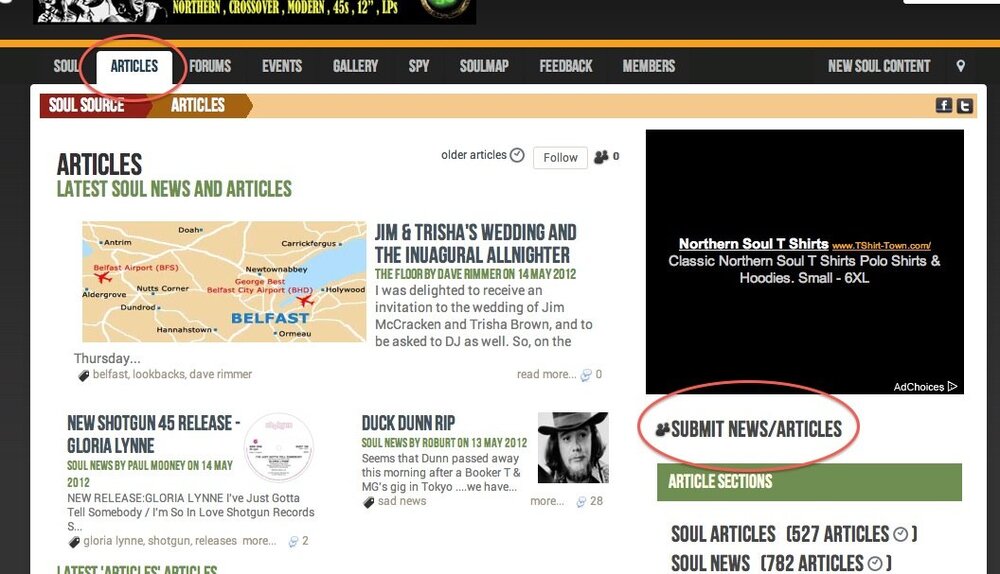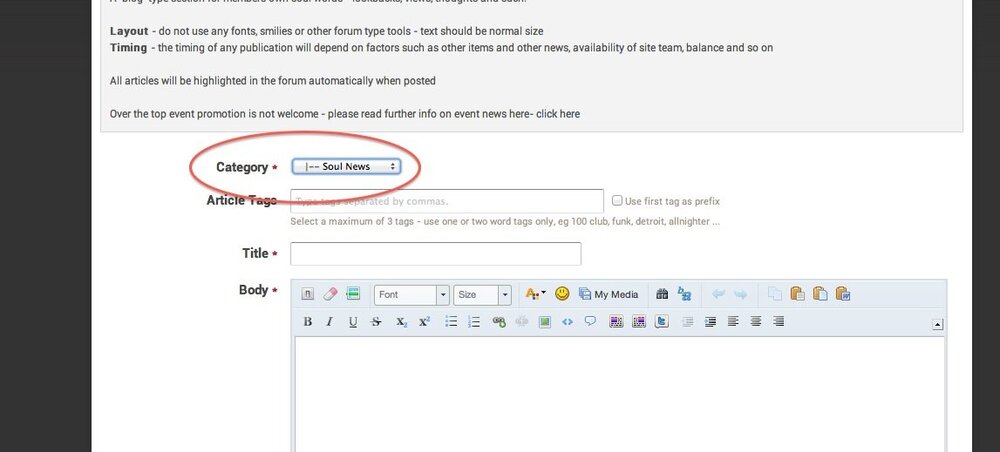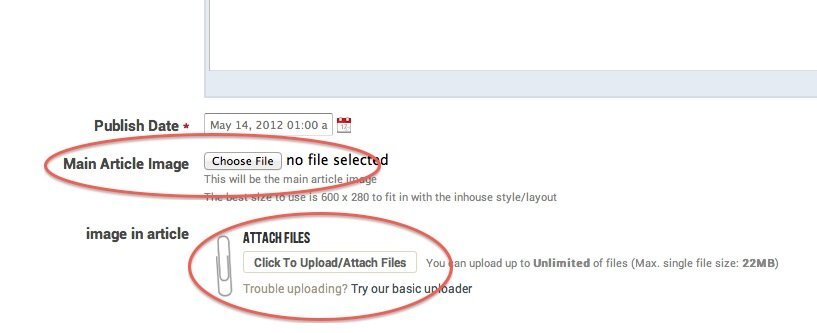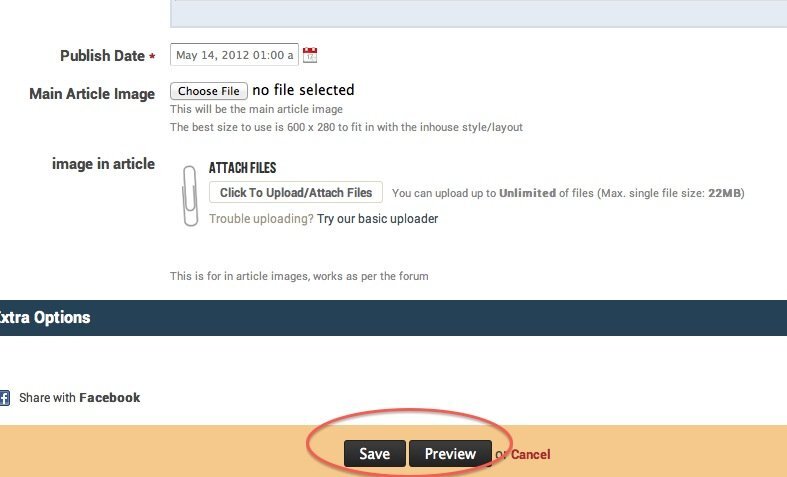Everything posted by Chalky
-
Tony Jebb (Golden Torch/Blackpool Mecca Dj)
Merged the two topics regarding Tony. I can help with some music if you need any Dave?
-
Guilty Pleasures
Two topic emerged. I think the first topic is two topics merged Len, so yes third attempt, if you follow.....
-
Dummies Guide To Submitting An Article
Just giving this a kick, seems a few unaware of articles or how to submit one. So if you have a forthcoming event, cd or 45 releases, or feel you had a good weekend, seen a act and wish to put our views into words then post an article. Remember though has to be in your own words and read like a magazine article, something others will enjoy reading.
-
Passions - Elvitrue & Satelite
Isn't "Hotpoint" the IYSMB side and "Irene" the flip?
-
Garnet Mimms - As Long As I Have You + More
Might be easier to get the US LP, that has the studio version on and other decent tracks, be a better investment IMO than the 45. There was one on ebay although it might have finished by now.
-
Dummies Guide To Submitting An Article
It would appear that very few are aware of the feature to submit an article. One advantage of an article is that it will be shown on the front page as well as the forum (All About The Soul) and in the process get your news article out to a (possibly) wider audience. To submit an article click on the Articles Tab at the top left of the page and then over to the right you will see the Submit Article link.... Then select the type of article it will be. From the drop select the type of article it will be submitted as..... There are four options but you only have access to two initially, Soul News and Floor. Article is self explanatory, usually about the artists, labels and people behind the records that feed this scene. Soul News can be an article about a forthcoming release from one of the many labels catering for the scene, or news about some CD release. Anything really that is newsworthy and would help mother members. Event News is again self explanatory although it must be about some one off special promotion that will interest many. So if you have a major weekender, or event featuring a live act then let everyone know via an article. If you have been to a gig, or wish to post a full lookback on a particular event then use the option Floor. Fill in your article title and tags. Tags will help if people are searching for information that is related to your article. Then type in the content of your article. Remember it must be in your words and give more than what an event listing would be, we don't simply want a cut and paste type job just giving details of the date of release of a forthcoming record or simple who what where for an event. It needs to be informative and with as much information as possible. You then need a main image for the article, this is the one that will be shown on the front page. Add this via the highlighted link. You can also add any other images to be used in the article via the link underneath. All that needs to be done then is to preview your article and if satisfied submit it. It will then be approved by the site, or rejected if site feels it does nothing that for instance an event entry would do. So plea as much info as possible and as pin formative as possible and something others will enjoy reading.
-
Years Ago...for A Moment...this Was Northern Soul....is It Now?
The label doesn't look too bad, just a shame what is in the grooves is terrible.
-
Sophisticates On Mutt
We all know what a record is actually worth and what it costs to buy one on this scene are two different figures. Tis one might only be worth £40 but you will be lucky to buy one for this that. The cheapest I've seen recently is I think $80 and three figures in £'s. What it cost someone 18 months ago or 20 years ago is irrelevant.
-
Jimmy Mack - A Woman Is So Hard To Understand
-
On Top Of The World - The Stafford All-Nighters Podcasts
Look forward to it Byrney mate. There are now 15 podcast with something like 20 hours of listening. One more for Adam to do then it's the 60's Mafia!!
-
Duck Dunn Rip
A real soul legend. R.I.P.
-
In Fear Of
Rather than slag the site or it's members maybe folk should try and post a topic of something more positive, might improve your opinion that way. Like me gran said "if nowt good to say say nowt! And can we leave any personal stuff off the topic, if wish to discuss clothing then fine but stick to the clothing.
-
On Top Of The World - The Stafford All-Nighters Podcasts
Cheers Peter. Adam always knew how to work the floor, the man had taste, even if it was "disco" to some!!!!
-
On Top Of The World - The Stafford All-Nighters Podcasts
Two podcasts for you today. Both featuring the plays from the Stafford era of Adam Buchanan. Plenty of Modern Soul from the day for those that have an open mind. First on https://www.soulunder...e445f1a-13.html James Walsh Gypsy Band - Cuz It's You Girl - RCA Jim Mancel - Easy Life - People City Music Annis - Don't Play Games - GTO Moody Scott - My lovely Lady - Straight Ahead Records Flight - Playing Your Games - SGA Natural Four - I Thought You Were Mine - ABC Paramount Admirations - You Left Me - Peaches Soulville Allstars - I'm Gonna Get To You - Soulville L. Allen - Can't We Talk It Over - Green Dolphin Constellations - I Don't Know How To - Gemini Star Bill Harris - Am I Hot Am I Cold - RCA Betty Wright - Give A Smile - Epic Harold Melvin - Prayin' - Source Leroy Burgess - Heartbreaker - Salsoul Mandrill - My Kind Of Girl (My Girl) - Arista WQBC - Love Me Anyway - Thunderbay Pretenders - Just Be Yourself - Carnival Timeless Legend - I Was Born To Love You - Bright Light Swiss Movement - I Wish Our Love Would Last Forever - Gold Records And the second one https://www.soulunder...b13c2c8-14.html Chuck Jackson - No Tricks - EMI Atlantic Starr - Cirlces - A&M Bronner Brothers - Pretty Boys - Neighbor Bobby Thurston - The Very Last Drop - Epic Demetri - Got To Be Real - Stand By Charles Veal - new Found Love - Capitol Loveman Ronnie Stokes - Touch You Again - Philly Town Lifestyle - Katrina - MCA E.J. Rice - Will You Be Coming Back - Platinum Records Alfie Davison - Love Is A Serious Business - Mercury Bobby Womack - Home Is Where The Heart Is - Columbia Gwen McCrae - Keep The Fire Burning - Atlantic Chuck Jackson - Waiting In Vain - EMI Sweet Cream - Flyin' High - Shady Brook Ramsey Lewis & Nancy Wilson - Closer Than Close - CBS Four Tracks - Charade - Note Goldie Alexander - Go Back - Chaz Ro
-
Seen Any Badly "produced" You Tube Soul Videos Lately?
I watch Bigrobs, they are quality but I would say 99% of the times I use Youtube for any track about this music is to listen, not to watch, unless it is a video that actually features the artist.
-
Seen Any Badly "produced" You Tube Soul Videos Lately?
But how many go on to youtube for the visual? Most visit to listen to the track and most want to see the details and besides most of the videos on Youtube are sh*te and unwatchable. Robsbigcitysoul (I think that is his user name) produces the best Northern ones by a country mile.
-
Nice Bit Of Info About,the Horse,cliff Nobles
I'm currently reading A House On Fire The Rise and Fall of Philadelphia Soul. It tells you how they came up with the instrumental and Jesse James wasn't even there, it was laid down and they got little recognition from Jesse for the track, he paid them no extra either, they simply got their session fee. After that Jesse James wasn't very well liked amongst the session musicians in Philly and many wouldn't work with again.
-
Beverly Ann - He's Coming Home
Tim's online guide is a bit different, £300 for DJ, £200 for issue yet he has a demo for sale at £125.
-
Beverly Ann - He's Coming Home
By the "book I take it that is JM Guide? The "book" actually adds VAT as well which is 20%.
-
Bob Tom
It is on youtube if correct one....??
-
Bob Tom
Please no file sharing links.
-
Album Only D.j.'s - Are There Any Out There ?
They are Kev, but you could take the LP with you and save space for half dozen extra 45's in the box.......a lot cheaper too than trying to buy the 45s now.
-
Promotional Photo Or Venue Posters - Anthony & Aqualads
Never seen one Mark. I've seen a more recent photo of The Entertainers with Earl Dawkins in it in the Heeey Baby Days of Beach Music. Probably something on the web as well.
-
Album Only D.j.'s - Are There Any Out There ?
A must have LP IMO is Garland Green's Jealous Kinda Fella, chock full of great tracks, shouldn't cost a lot either.
-
Seen Any Badly "produced" You Tube Soul Videos Lately?
Youtube is full of them. They still persist in putting up crap videos where the sound is recorded through the cam, if they can't at least record the sound through the system then why bother. It isn't like tracks like Anita Humes isn't already up there.







